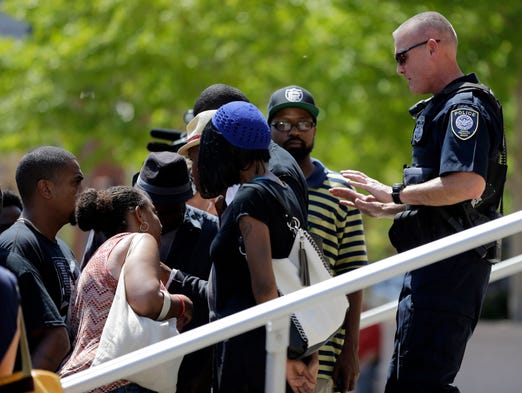A makeshift memorial for fallen law enforcement officers in Dallas continues to grow in front of the city's police department. Mike Rawlings, the city's mayor, says he has gotten "texts from all over the world." (July 9) AP
Corrections & Clarifications: A previous version of this story incorrectly identified the number of officers killed in the line of duty in 2016. Last year, 143 officers died in the line of duty, with 66 of them shot and killed.
The number of law enforcement officers killed in the line of duty dropped sharply in 2017, marking the second-lowest toll in more than 50 years.
As of Thursday, 128 officers have died in the line of duty this year, with 44 shot and killed. That's down 10% from 2016, when 143 officers died, with 66 gunned down, according to data released by the National Law Enforcement Officers Memorial Fund, a nonprofit aimed at honoring officers and improving safety.
The only other year with fewer deaths in the past five decades was 2013, when 116 officers were killed.
"This is one of those good-news, bad-news situations," said Craig Floyd, president and chief executive of the fund. "On one hand, you had 128 officers who made the ultimate sacrifice, showing the cost of public safety, but for the first time since 2013, the number of deaths has actually declined."
Reasons for the drop could range from advanced safety gear such as bulletproof vests, better training, better relationships and reduced violence in communities — or just 2017 being an outlier, experts say.
"It's definitely a good sign but if it's a trend, we'll have to see," said Geoffrey P. Alpert, a professor at the University of South Carolina and a researcher on high-risk police activities. "We're starting to see the impact of all this new training and equipment, and a shift because of the overall concern for officer safety."
While shootings played a big role, traffic accidents caused the largest number of deaths. Crashes killed 47 officers this year, down 15% from 2016. A number of factors — including enhanced policies that limit vehicle pursuits and speeding and the "move-over law," which requires drivers to slow down and switch lanes when an officer is pulled over — could be behind the drop, experts say.
Texas, as in previous years, tallied the highest number of law enforcement officers killed on the job with 14 deaths, followed by Florida and New York, both with nine deaths.
Across the U.S., ambush-style attacks killed eight officers in 2017, a decrease from a jarring 21 such deaths in 2016. The largest number of fatal shootings this year occurred while officers responded to domestic disturbances.
Randy Sutton, a former police lieutenant and spokesman for Blue Lives Matter, an advocacy group that supports law enforcement, said multiple reasons likely led to the drop in killings, including a change in how officers approach arrests because of the controversial high-profile shootings in recent years. Officers don't put themselves in dangerous situations as often, he said.
"There's a saying in law enforcement: You can't get in trouble for the car stop you don't make," he said. "They don't want to be the next Ferguson, the next officer burned on the stake."
The number of people killed by officers increased slightly from 963 in 2016 to 971 this year, according to data compiled by The Washington Post. But the number of high-profile shootings that sparked protests was far lower than previous years, Floyd said.
"I'm hoping this is a sign that officers have restored some of that trust, especially in communities where that relationship has been torn," he said, adding that body-worn cameras have helped departments become more transparent and stop violence before it begins after controversial incidents.
Floyd said there have also been significant improvements in de-escalation training and improved safety equipment provided to officers.
But some of those advancements could point to why this year's data may just be an outlier, said Justin Nix, a criminal justice professor at the University of South Carolina.
There's no way of knowing the number of times officers nearly died or were shot at but survived because a bullet hit their tactical vest instead of their body, he said. "Random chance" sometimes plays a role in these incidents, he said.
"Every year, 100 to 150 officers die in the line of duty. It's a relatively small number when you consider the half a million officers nationwide, so it's going to bounce around," Nix said. "This decrease is definitely a good thing, but there's no way of knowing whether it might go up again next year."
Floyd said he hopes it's a trend that is here to stay and points to an overall downward shift in the number of officers killed going back to the 1970s.
"In my 33 years doing this, I've never seen the amount of awareness given to officer safety and wellness," he said. "That's definitely been paying off and will continue to help make law enforcement a significantly safer profession."
Follow Christal Hayes on Twitter at @Journo_Christal














































































































































































































































































No comments:
Post a Comment
Thanks for commenting. Your comments are needed for helping to improve the discussion.